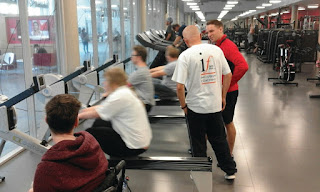Hi folks and welcome to my latest Blog post. A while back I produced a series of videos which were filmed at the Inspire Fitness Gym, in Suffolk. The videos were aimed at Coaches, Gym Instructors, Personal trainers and others who might be providing an exercise program for someone with a disability. There were six videos in total, covering areas such as Physical, Sensory, Emotional and Cognitive disabilities as well as looking at Mental Health conditions. The videos were designed to give people a brief overview of the conditions, along with some practical advice to help instructors better support their clients.
Today's Blog is based on the video that dealt with physical disability and it follows on quite nicely from a post I wrote a few weeks back called "The importance of functional fitness to amputees".
In today's post we are going to be talking more generally about physical disability, not just amputees. So we are thinking about, Wheelchair users, people with spinal injuries, cerebral palsy, muscular dystrophy and people with conditions that generally affect their muscular skeletal, circulatory and nervous system.
In today's post we are going to be talking more generally about physical disability, not just amputees. So we are thinking about, Wheelchair users, people with spinal injuries, cerebral palsy, muscular dystrophy and people with conditions that generally affect their muscular skeletal, circulatory and nervous system.
So, if you are working with a client with a physical disability, or indeed any disability, it's important that you find out as much as you can about the condition. The best to do that is to ask. Have a conversation. Unlike someone with a neurological disability, who may find it harder to communicate, generally someone with a physical disability will be happy to talk about their condition. After all, they own their physicality. They are the experts since they live with their condition 24/7
So, where do we start? Well at the beginning it's best to establish some parameters. What is their current level of fitness, range of movement etc... This is going to set a bench mark and help you to work with your client more effectively. So for example, if your client is a wheelchair user, they may have damaged their spinal cord resulting in paraplegia, affecting movement of their lower body. Or, they have more severe damage resulting in Tetraplegia affecting all four limbs with possible issues affecting other parts of their body.
So it's obviously important to establish how much loss of movement there is, and this may well vary from person to person, even between people who appear to have a similar condition, even having damage to the same part of the spinal cord. On the other hand, if you are working with someone that has cerebral palsy, you may have more scope to work with them. Whilst they may find some exercises challenging, there is no reason why gentle routines designed to extend a client's range of movement shouldn't be affective. Their physical condition and range of movements may never be as great as someone without the disability, but general fitness, balance, coordination and range of movement can all be improved.
On a practical level, when working with someone with limited mobility, think about seated exercises. If you have had any experience working with older adults you will have come across Chair Based exercises.
These are a really good place to start, because it enables you to assess your clients physicality and what they are capable of. Even if you want to move them on quite quickly to a more rigorous exercise regime, this type of more controlled exercise gives you more scope and flexibility when it comes to careering for your client. Chair Based exercises enable you to ensure that they are stable and you can monitor closely their level of fitness, which might be quite low. In any event, they are likely to fatigue more quickly. If they are seated this will be a safer position for them.
Consider using exercise bands sometimes called resistance bands. Resistance bands are brilliant. They can be used lying down, standing and seated. So they are perfect for wheelchair users.
You can also use dumbbells. Small dumbbells are good because sometimes you may have clients with difficulty with their grip. Wheelchair users my have difficulty keeping their heart rate up so you need to be keeping their upper body moving and working out with small dumbbells work well. With people who have physical disabilities make sure that you build in sufficient rest periods into your routines. Recovery is key if your client is going to progress. I mean you know that as fitness professionals, but it's even more important with someone with a physical disability.
I do a lot of work with amputees, particularity amputees with lower limb loss. So the work that I do in the gym is based around balance and strengthening the Core and functional fitness generally. My work also tackles issues of confidence. Confidence regarding working out in a gym environment generally but also confidence in the use of their prosthetic.
Many people have a problem with feeling that they can't rely on their prosthetic and this makes them feel unsteady on their feet. Working on balance improves confidence.
The bottom line when working with a client that has a disability is to allow a little more time. Patience is key, like a lot of things in life.
Not everyone that you work with will want to become a Paralympian but do allow yourself the space to work with your client effectively and help them be the very best that they can be. The fact that they have a disability shouldn't mean that you do any less.
See you all next time.
Bye for now.





No comments:
Post a Comment